
The ancient Indian medicine of Ayurveda is based on a profound knowledge of the body, and its relationship with the mind and spirit. It therefore considers health as a state of balance, in which psychological and environmental factors are as important as physical ones.
Born in India thousands of years ago, Ayurveda is not only a science for physical well-being: it is also philosophy, psychology, science of the spirit and - as its name says - a "science of life" projected to complete physical well-being and mental.
Ayurveda develops in various subjects closely linked to each other, so as not to be able to divide them thematically. In particular, it consists of: Fundamental elements; Uniqueness of the individual; Ayurvedic diet, Ayrvedic lifestyle; Ayurvedic Cures and Ayurvedic Remedies. The backbone is not so much the remedies - which, although strongly emphasized in the West for commercial reasons, constitute a marginal part if one wants - as much as the lifestyle, therefore the philosophy. With a philosophical flight we can say that ayurveda and anthroposophy *, even if one is rooted in the East and the other in the West, have a common basis: they are both external and internal lifestyles, and are complementary medicines. The success of Ayurveda in the West is therefore also due to its position as complementary medicine; as such it joins technological medicine without replacing it.
* Anthroposophy: natural-cosmic medicine with a wide range of knowledge. The disease is studied in its physical, etheric, astral and spiritual body evolution, within a destiny that embraces more earthly lives.
The constitution of the matter

The universe is governed by five elements: ether, air, earth, fire and water, and man is made up of a combination of these five elements.
The constitution of the body: the doshas
In the subject there are also three main bio-energies, called doshas, composed of various combinations of the five elements.

Most individuals have a predominant dosha, which determines the basic type of body and the temperament of the individual.
Dosha Vata
In the vata area five types are further distinguished, governed by different dominant bodily locations: prana (the head), udana (the chest), samana (the stomach), vyana (the heart) and apana (pelvis). Each of these has a precise localization in the body and governs different physiological systems. The imbalance of each of these causes specific disturbances.
CHARACTERISTICS OF THE INDIVIDUALS WITH PREDOMINANT VATA- Slim body and little weight gain
- Dry, rough skin, which easily cracks
- Predisposition to dental caries
- Small, expressionless eyes (not always)
- Fast and irregular food intake
- Irregular memory
- Insomnia and restlessness
- Tendency to gnaw nails
- Strong character
- Ability to earn money quickly and spend it just as quickly
- Difficulty maintaining relationships
- High sexual drive
- Dreams of flying, jumping, climbing, running and tall trees
An example: the vana apana resides in the vertebral column, in the rectum, in the bladder and in the genitals. It governs the urination, defecation, menstruation and the movement of the fetus leaving the uterus. According to Ayurveda, an imbalance of this type of vata causes cono-rectal, urogenital and intestinal disorders.
Some symptoms of a vata imbalance.
An excess of vata influence could cause the following symptoms: a darker than normal color, dry lips, dry eyes, dry cough, dark yellow urine and hard, dry and dark stools. In short, according to Ayurveda an excess of vata leads to dehydration of the entire body, there is too much air and insufficient quantity of water.
Dosha Pita
Within the pitta sphere five types are further distinguished, governed by different dominant bodily locations: pachaaka (the stomach), ranjaka (the liver) sadhaka (the heart), alochaka (the eyes) and bhrajaka (the skin). Each of these has a precise localization in the body and governs different physiological systems. The imbalance of each of these causes specific disturbances.
- Medium build, neither too slender nor too heavy
Soft skin, possibly with moles and freckles
- Eyes small, often green, brown l gray
- Enjoy your meal, but with no tendency to gain weight quickly
- Veins, musculature and medium bone
- Thin hair with a tendency to fall (males tend to baldness)
- Abundant, often excessive perspiration
- Moderate sexual impulse
- Living intelligence, tending however to excesses of anger and to make judgments
- Open to new ideas
Strong character and quality of leader
An example : the pitta sadhaka resides in the heart and governs intelligence, intellect, creativity, memory, self-esteem, the ability to achieve results, and romantic attitudes. It is not yet known if this pitta, which governs mental functions more than physical ones, is the heart itself or acts for the whole body. An imbalance undermines the proper functioning of the aforementioned functions.
Some symptoms of a pitta imbalance
An imbalance of pitta can lead to the following disorders: poor digestion, an irregular body temperature, excessive transpiration, weakened vision, mottled skin and other skin disorders, irritable intestines and diarrhea, anxiety and irritability. Most Ayurvedic doctors believe that illnesses caused by a disturbed pitta are less serious than those due to vata imbalance.
Dosha kapha
Within the kapha framework, five types are further distinguished, governed by different dominant bodily locations: kledaka (stomach), avalambaka (thorax, heart), bodhaka (tongue), tarpaka (head), sleshaka (joints).
- Body prone to fat accumulation
Skin and hair are thick and fat
- Clear white eyes
- Thick heavy eyelids
Not prominent veins and muscles
- Heavy frame
- Strong body odor
- Slowness, clumsiness and tendency to inactivity
- Approach to sex without fantasy
- Tendency to sleep too much
Medium intelligence
An example: the tarpaka kapha resides in the brain, and maintains its strength. An imbalance causes headaches, nausea, insomnia, dizziness, diarrhea and mental disorders.
Some symptoms of kapha imbalance
According to ayurveda, a kapha energy imbalance can induce the following symptoms: a thin and flaccid appearance due to poor nutrition, loose joints, a weak and too soft body, impotence, slow digestion, excess mucus and overwhelming feelings of jealousy, insecurity and intolerance.
According to ayurveda, in addition to the three main types of doshas, individuals can fall into numerous subgroups, such as vata-pitaa, vata-kapha, pitta-kapha.



